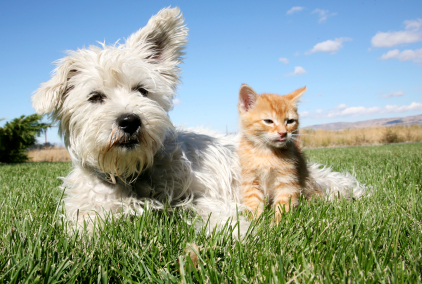Summer Heat Affects Pets
Summer weather has officially arrived in the Lower Mainland and with that comes increased outdoor fun with our four-legged companions. Whether you’ll be hiking, biking or just playing fetch with your pet this summer, one thing to keep in mind during this warm Vancouver summer is to ensure your pet has a chance to cool down. Hyperthermia or heatstroke is an elevation of the core body temperature due to environmental conditions. Normal body temperature for pets is 38.6C +/- 1C, but too much sun and activity can raise their temperatures. Heatstroke can be life threatening, as it can cause damage to the heart, lungs, kidneys, circulatory and nervous system, meaning your pet would require immediate treatment. The most common causes of heatstroke include:
- When an animal is left in a hot car.
Even on a relatively cool day, the temperature inside the car can raise to unsafe levels
| Outside Air Temperature (Celsius) | Inside Car Temperature (Celsius) |
| 21 | 38 |
| 24 | 43 |
| 27 | 49 |
| 29.5 | 54 |
| 32 | 60 |
- When an animal is left outdoors in hot weather without adequate shade.
- Overly strenuous physical activity on a warm day, especially if your pet isn’t acclimatized to the weather or level of activity.
Some pets are particularly susceptible to heatstroke, including young, geriatric or obese pets, those already with breathing difficulties such as brachycephalic (short nosed) dogs (Pug, Lhasa Apso, Boston Terrier, etc.) and those with laryngeal paralysis. Signs of Heatstroke: Initially, your pet may appear distressed or restless. As hyperthermia progresses your pet may drool large amounts of saliva from the nose or mouth and pant excessively. In more severe cases your pet may become unsteady on his feet, his gums may turn blue/purple or bright red (due to inadequate oxygen) and may collapse. What to Do:
- Move your pet to a cool, shaded environment.
- If possible, determine the rectal temperature and record it.
- Begin to cool your pet.
- Direct a fan on your pet.
- Place cool, room temperature wet towels over the back of the neck, in the armpits and the groin area.
- Wet the paws and earflaps with cool water.
- Transport to the closest veterinary facility immediately for continued care, where your pet will be monitored and treated for secondary complications that occur in more severe cases.
What Not to Do:
- Use cold water or ice for cooling
Use of water that is too cold will cause the superficial blood vessels to shrink, which will delay the cooling of the innermost structures of the body.
- Overcool your pet
Active cooling should be discontinued once the rectal temperature reaches 39.2-39.4C.
- Force water into your pet’s mouth.
You can offer water for your pet if he shows interest in drinking. Use tap water temperature water, not ice cold water.
- Try to manage this yourself
After doing initial first aid, severe hyperthermia is a disease that affects nearly every system in the body. Simply lowering the body temperature fails to address the potentially catastrophic events that can accompany this disorder. A pet suffering from hyperthermia should be seen by a veterinarian as soon as possible. Heatstroke is something we should all be aware of during these warm weather months. It is highly preventable and hopefully you and your pet can have a cool and fun-filled summer. 

